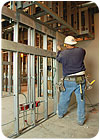

SMOKE BARRIERS (Section 709) are fire-resistance rated construction intended for the division of a building area into separate smoke compartments. Smoke barriers are used for three main groups:
1. Group 1-2: Smoke barriers are used to divide patients for sleeping or treatment. Divide stories to groups of two and/or a maximum compartment area of 22,500 square feet.
2. Group 1-3: Smoke barriers divide the stories occupied by residents for sleeping. Divide stories to groups of two and/or a maximum of 200 residents in any compartment. Allow maximum distance of 20 feet to the door of the smoke compartment. Allow a maximum travel distance of 150 feet to the exit access door to the smoke compartment door.
3. Areas of Refuge: An area of refuge is required for accessible means of egress. It is required to be separated from the building area by smoke barriers.
The construction of smoke barriers requires a one-hour fire rated construction. Continuity of the smoke barrier must be from exterior wall to exterior wall; from floor to slab or deck above. The difference between a fire partition and a smoke barrier is the interstitial spaces. In fire partitions, they must be one-hour rated through the interstitial space, in smoke barriers the partition in the interstitial space is only required to resist the passage of smoke.
SMOKE PARTITIONS (Section 710) are much less restrictive and are not required to be a fire-resistant rated wall, unless specifically called for by the architect. These partitions are intended only to resist the passage of smoke. Smoke partitions may be terminated to the underside of a ceiling membrane designed to prevent the passage of smoke.
I am often asked if the smoke seal used on the smoke partition is required on both sides of the partition. Most code officials will require both sides of the smoke partition be sealed to resist the passage of smoke.
If you have a question for Cracking the Code, send it via e-mail to Jay McNally, editor of Walls & Ceilings magazine, at mcnallyj@bnpmedia.com. Please include “Cracking the Code” in the subject line.




Report Abusive Comment